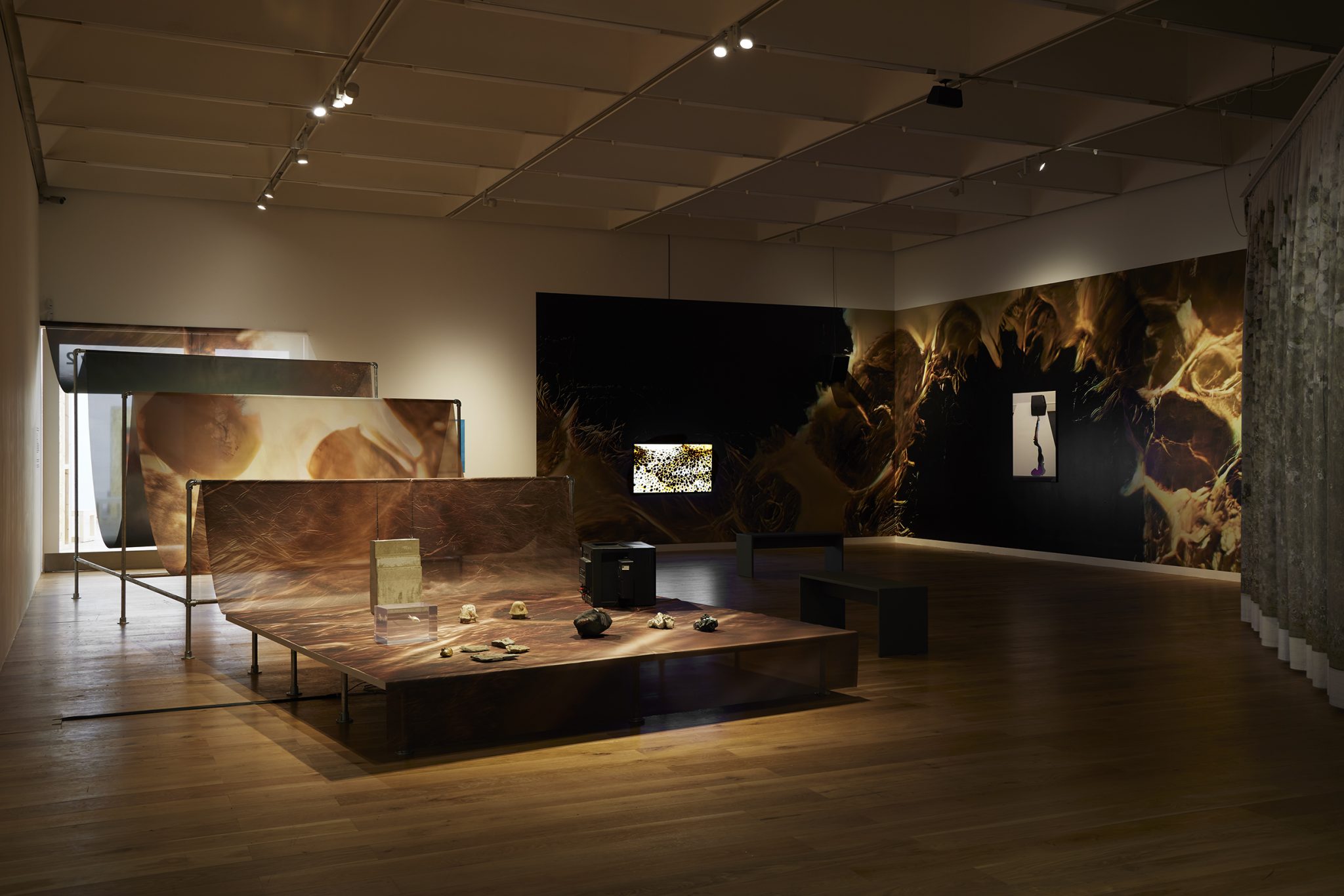A profound exhibition-as-sci-fi story at Nottingham Contemporary provides a narrative distance that avoids the eco-anxiety usually associated with climate change
Developed by exhibiting artists Céline Condorelli, Grace Ndiritu and Femke Herregraven, this is an exhibition-as-sci-fi story, envisioning a not-so-distant future shaped by climate change; seasons have gone, fires decimate Sherwood Forest and Nottingham is reborn as the Silver City (itself further explored in Our Silver City, 2094, a novella written by sci-fi author Liz Jensen for this exhibition). Operating in a contemplative register, the show highlights collaboration as a mode of practice and deploys a wide range of artworks in parallel with speculative fiction to highlight some of the most pressing issues facing us today. In short, it’s an exploration of art in activist mode in which it serves to prototype and consider new ways of being.
The opening gallery delves into the central theme of change, with artworks and artefacts from different decades presented on chipboard stands, like a visual archive of proposals for the future. Maps of Nottingham from the 1800s to the 1980s illustrate a city in industrial flux. Anthony McCall’s video Landscape for Fire (1972) shows a choreographed grid of fire set and burnt repeatedly in an airstrip field; Zara Zandieh’s video Octavia’s Vision (2021) captures queer liberation, decolonisation and environmental movements through the retelling of stories by Octavia E. Butler.
A multimedia gallery considers the need to develop new technologies for a new city. Fossils and fake rock clusters are mixed in with short films and a sound piece. Large textiles and a wall print by Condorelli explore colour-producing methods inspired by cephalopod mimetic abilities. Her printed fabric Resuscitated Aural Study (2021) drapes across the gallery on a series of metal bars like a drying skin, morphing from awning to stonelike table. The images of organic, cellular globs on a curtain and tentaclelike wall prints, however, are nondescript and miss the connection with the narrative.

Ndiritu’s and Herregraven’s immersive installations look for nonmaterial connections in community and the environment respectively. Ndiritu builds community in The Temple (2021), a lifesize model for a modern, circular museum that invites conversation and commonality. Handmade goddess sculptures and weavings depicting fabric as an ancient technology feed curiosity for traditions. Herregraven’s Wet Spells (2021) is a serene, anachronistic weather lab premising a world from which supercomputers have disappeared, where weather is once again predicted through the use of our senses. Weather lore is transmitted by crackly children’s voices over makeshift antennae, and new meteorological symbols line the walls. The brilliant addition of a curse tablet to the weather gods, a genuine archaeological find dating from 400BCE, grounds the farflung method.
Both installations develop a sense of spirituality through self-reflection and the ambition to find meaning and direction through inner knowledge, ancient wisdoms and the environment rather than through religion. It touches on the rise of spirituality among millennials and Gen Zs, who, with little faith in patriarchal institutions, have turned to spiritual practices including Wicca, meditation and yoga to improve individual wellbeing. Our Silver City, 2094 suggests that the embodied connection and openness developed by spiritual practices can help build communities and promote positive coexistence with our surrounding environment. It’s convincingly enough executed to instil a sense of optimism about self-directed change.

Since it’s a fiction, the exhibition provides a narrative distance that avoids the eco-anxiety usually associated with climate change. The bleakest artworks, Ben Rivers’s Urth (2016) and Cauleen Smith’s Song for Earth and Folk (2013), short films that foresee humans becoming extinct, are offset by the exhibition’s themes of progress with positive intent and instead inspire a sense of agency.
Combining art, writing and historical archives to narrate a story, Our Silver City, 2094 demonstrates the potential of different artforms to engage with the looming climate crises positively while inspiring change. It educates without preaching and explores futures tangibly, removing abstraction, to encourage imaginative engagement.
Placing the exhibition 72 years ahead brings the future close enough to be relevant; it is not so far away that you cannot connect with it. The conceptual time-jump urges you to consider what children of today may need to survive and how we impact that. Rather than make demands, the show asks only that you have listened to, seen and experienced what is possible. That this is done without scaring people, without multinational COP agreements and without insisting that people change makes it a profound exhibition.
Our Silver City, 2094 is on view at Nottingham Contemporary until 18 April
